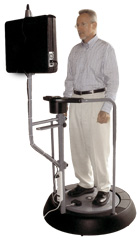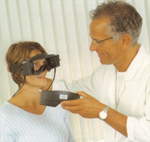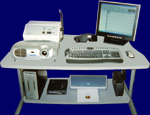Common Threshold Values
| Diagnostic Test | Abnormality Threshold | Clinical Significance |
|---|---|---|
GAZE & SPONTANEOUS NYSTAGMUS Nystagmus: slow component, followed by fast component.Bilateral gaze nystagmus: eyes open and looking to right or left. |
2 Beats (horizontal) in 5 sec. with average velocity of >6 deg/sec. |
CNS: nystagmus in all gaze directions or direction changing nystagmus in same gaze direction. SPONTANEOUS NYSTAGMUS: CNS (brain stem) PVS: direction-fixed,horizantal, or torsional nystagmus. Inhibited by fixation, follows Alexanders law.* rule out drugs, lack of alertness. |
SMOOTH PURSUIT/ TRACKING Gain: eye velocity/target velocityAsymmetry: right gain – left gainPhase: lag or lead of eye relative to target. |
Gain: Age 50 and under - <70% or >140% Age 60 – 69 - <65% or > 145% Age 70 – 79 - <60% or > 150% Age 80 – 89 - <55% or > 155% Age 90 and above - <50% or >160% Gain asymmetry: >30% |
Low gain in one direction: CNS lesion.Marked saccadic pursuit:(stair step tracking) CNS lesion |
SACCADE TEST Latency: reaction time in msec.Accuracy: undershoots/overshoots Velocity: peak eye velocity |
Latency: Age 50 and under - >260 msec Age 60 – 69 - >270 msec Age 70 – 79 ->280 msec Age 80 – 89- >290msec Age 90 and above – 300 msec Velocity: Age 50 and under - <240 deg/sec Age 60 – 69 - < 230 deg/sec Age 70-79 - <220 deg/sec Age 80-89 - < 210 deg/sec Age 90 and above - <200 deg/sec Accuracy: <55% |
Significant saccadic slowing, overshooting or undershooting:CNS lesion or ocular disorderLower velocity of trailing eye:Internuclear ophthalmoplegia ( Brain stem) |
OPTOKINETIC NYSTAGMUS Gain: eye velocity/ target velocity. |
Gain < 60% is abnormal. Symmetry > 30% difference is abnormal. SPV < 6.0 is abnormal |
Symmetrical low gain: impaired vision or likely CNS (parietal) lesion. |
TORSION W/fix |
Normal evoked nystagmus should be observed. Fixation reduces nystagmus by 50%< 50% Suppression with fixation is abnormal. |
If evoked nystagmus is not observed PVS lesion. Lack of suppression with fixation = CNS lesion. |
DIX-HALLPIKE |
>2 beats (horizontal) with average velocity >6.0 deg/sec. • delay onset of nystagmu • paroxysmal nystagmus • associated with vertigofatigable nystagmus |
Unilateral: Usually peripheral undermost ear. Bilateral: peripheral (both ears) or CNS BPPV: both horizontal and vertical nystagmus (with possible rotation) observed. |
POSITIONAL TEST |
>2 beats (horizontal) with average velocity >6.0 deg/sec in 5 sec. • changes direction in a single head position. • Persists in 3 or more head positions. • Is intermittent in 4+ head positions. | Eyes open Direction fixed: usually peripheral. Direction changing: usually CNS. Direction changing in single head position: CNS |
CALORIC TEST Directional Preponderance: nystagmus beats stronger one way than another. Fixation Index: when nystagmus is at its peak, the ratio of velocity with no fixation to velocity with fixation. |
Unilateral weakness: of more than 25% is abnormal. Bilateral weakness: sum of velocities of all 4 irrigations <20 deg/sec. Directional preponderance: >25% difference. |
Caloric weakness: is a function of the labyrinth or Vlll cranial nerve (vestibular portion). Unilateral: indicates disabled side. Bilateral: both peripheral organs, acute unilateral lesion or perhaps CNS (cerebellar). Directional preponderance: is not localizing. High fixation index: is a prime indicator of CNS. |
* THESE COMMENTS ARE GENERALITIES. EXCEPTIONS OCCUR.
Prepared by: PREFERRED PROVIDER CARE, INC. 4/07/05




